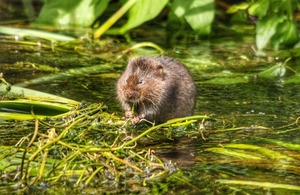The Water Vole has made Hull Road Park its new home
After 30 years of decline and no official recordings ever in Hull Road Park, the Water Vole has made the park in York its home.

An example of a Water Vole - credit: Jonathan Ridley
The Water Vole lives along vegetated banks of slow-flowing streams, rivers and ponds and in this case has been found in Oswaldbick beck that runs through the park.
Water voles are Britain’s largest vole species, with a rounded face, blunt nose, small ears and dark brown or almost black fur. Their tail, which is two thirds the length of their head and body, is dark and covered in hair.
They can often be identified from the distinctive ‘plop’ sound they make when they dive into the water.
The Water Voles’ newfound progress is not a coincidence. Since 2017 the Environment Agency has been working with partners on the York Urban Becks project to restore wildlife habitat in the city thanks to Water Environment Investment Funding.
The project looks to help improve the conditions for biodiversity to thrive along some of Yorks waterways and is further supported by a Yorkshire area flood and coastal risk management (FCRM) biodiversity enhancement scheme.
With the collaboration of City of York Council and the environmental charity St Nicks, they have specifically focused on water voles along Tang Hall and Osbaldwick becks.
The success of the scheme has meant that the voles have managed to spread out along Osbaldwick beck as far as Hull Road Park, which lies close to an urban area.
Gail Hammond, Environment Programme Manager at the Environment Agency said:
The water vole has undergone one of the most catastrophic declines of any species in the UK, so we have been working hard to improve habitat for water voles across Yorkshire.
There is still much to be done but the recent sightings in York can give us hope that when people work together for wildlife that species can recover.
Jonathan Dent from St Nicks in York said:
We’ve had some very clear sightings over the last few weeks and identified field signs during instream surveys that 100% confirm their presence.
This is really promising and a good indicator that the beck habitat is improving, with enough vegetation cover and diversity to support water voles.
Water voles are fondly referred to as ‘ecosystem engineers’, their burrowing and feeding activity supports biodiversity, creating opportunities for wetland plants and other animals to thrive. With the presence of water voles, we should see even more diversity developing within the beck habitat.
Cllr Jenny Kent, Executive Member for Environment and Climate Emergency, at City of York Council, said:
Water voles in York is great news – for them and for York’s environment! To help reverse the decline of this endangered species in a city park is a real achievement and is an encouraging sign of healthier riverbanks, enabling the population to expand their territory and thrive.
It’s a real tribute to the hard work of all our partners and volunteers in this scheme, which is hugely valued.